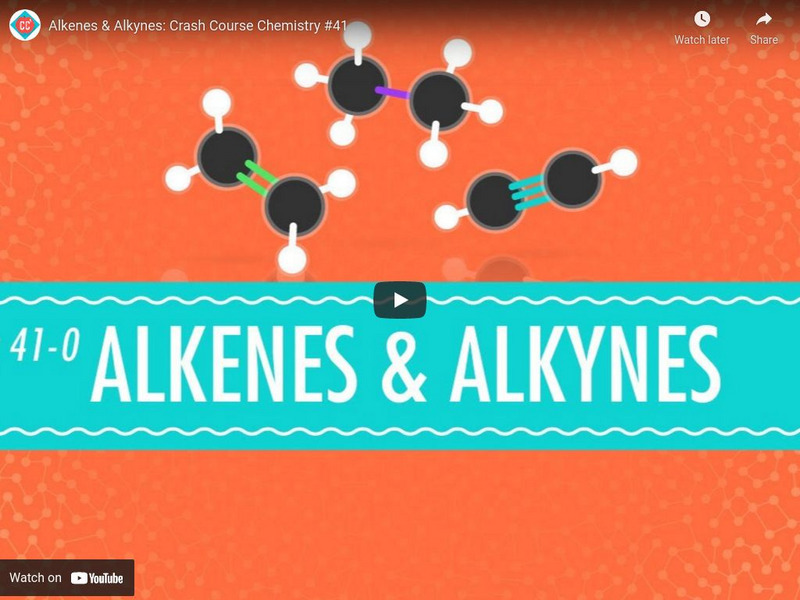Hi, what do you want to do?
SciShow
Do Fat Cells Ever Really Go Away?
Okay- you lost weight, but what actually happened to those fat-storing cells?
Crash Course
Carboxylic Acid Derivatives & Hydrolysis Reactions: Crash Course Organic Chemistry
Esters have a wide range of uses, from giving perfumes and colognes their fragrances, to preventing diseases like scurvy. Vitamin C, that scurvy preventing antioxidant, is derived from carboxylic acids, a class of organic compounds we’ve...
Bozeman Science
Carbohydrates
Paul Andersen begins by explaining the structure and purpose of carbohydrates. He describes and gives examples of monosaccharides, disaccharides, oligosaccharide and polysaccharides. He explains how they grow through dehydration...
Curated Video
Lipids
Organic molecules that contain long carbon chains or rings and which tend to be insoluble in water, though soluble in organic solvents. A Twig Science Glossary Film. Key scientific terms defined in just 60 seconds using stunning images...
Science ABC
Does Water Make Grease Fires Worse?
Water and oil do not mix (immiscible liquids) because water is polar and grease oil is non-polar. They do not form intermolecular bonds and instead repel each other. There is a separation of oil and water layers. The denser liquid falls...
Institute of Human Anatomy
How Your Body Really Burns Fat: Can We Control It?
In this video, Jonathan from the Institute of Human Anatomy explores the ins and outs of fat loss. He breaks down what fat loss really means how it works, and tackles a burning question we all have when trying to shed those extra pounds:...
The Wall Street Journal
Case Study: Heart Disease
At the 2020 WSJ Health Forum, Senior Writer Betsy McKay spoke with Dr. Nieca Goldberg, medical director of the NYU Women's Heart Program, and Verve Therapeutics CEO Dr. Sekar Kathiresan about the troubling rise in heart disease.
Catalyst University
Lipase Test | Theory & Results
In this video, we explore the theory and results of the lipase test in microbiology.
Catalyst University
Anatomy & Physiology of the Stomach [Part 2} | Lipases in the Stomach
This is follow-up video to the stomach video in which I briefly discuss the lipase functions within the stomach: [1] gastric lipase [2] lingual lipase (from the oral cavity's intrinsic salivary glands)
Catalyst University
Pancreatic and Brush Border Enzymes of the Small Intestine
Here, we discuss the functions of the major brush border and pancreatic enzymes of the small intestine. Chapters View all Physiology of the Small intestine 0:12 The Small Intestine: The Brush Border 1:57 The Small intestine: Brush Border...
Catalyst University
What are the Physiological Mechanisms of Dietary Fiber?
We have all heard that dietary fiber is necessary for good GI and overall health. Human intestinal cells do not have enzymes to break down fiber, so how could this be? Here we will discuss the role of bacteria in fiber metabolism and...
FuseSchool
Biological Molecules
Molecules make you think of chemistry, right? Well, they also are very important in biology too. In this video we are going to look at carbohydrates, proteins and lipids. When I say lipids, I am talking about fats and oils. Life...
Curated Video
Complete health screening services including blood pressure, cholesterol check, vision, and hearing test
This video transcription highlights various health screening services such as blood pressure screening, cholesterol check, lipid panel, blood glucose test, bone density scan (DEXA scan), and colon cancer screening. It also emphasizes the...
TED-Ed
What Is Fat?
An animated fat molecule explains how some fats are beneficial and some are harmful. He describes triglyceride molecules and how the chemical bonding or overall shape determines the health value of each individual type of fat. This...
Other
Ebsco Publishing: Health Library: Understanding Cholesterol Levels
Short video explains what cholesterol is, how it builds up in blood vessels, and other risk factors associated with heart disease.
Crash Course
Crash Course Chemistry #41: Alkenes & Alkynes
A crash course in alkenes and alkynes, their structures, and how to remember which is which. [9:36]
Sophia Learning
Sophia: Lipids: Lesson 6
This lesson will explain the structure of lipids as well as discuss their function in our bodies. It is 6 of 7 in the series titled "Lipids."









